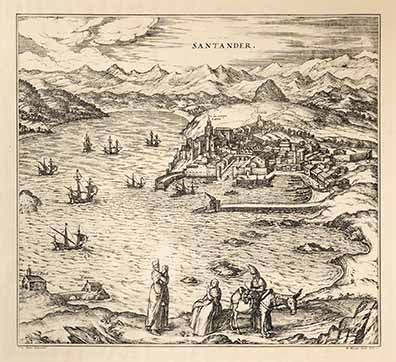
Mathäus Merian (Basilea, Suiza, 1593 - Bad Schwalbach, Alemania,1650)
View of the Santander Bay
1638
WORK INFORMATION
Etching on paper
Matthäus Merian, engraver and publisher. Based on the drawing of the city of Santander made by Joris Höfnagel for the piece Civitates Orbis Terrarum by Abrahan Ortelius and coordinated by Georg Braun in 1575. Taken from the book Neuwe Archontologia Cosmica by Johan Ludwig Gottfried and published in Frankfurt in 1638.
The draughtsman Joris Höfnagel and the engraver Franz Hogenberg are the authors of the oldest view we have of the capital of Cantabria, which first appeared in the editorial project of the most complete collection of panoramic views, plans and historical, social or economic commentaries of various cities in the world, known as Civitates Orbis Terrarum, the work of Abrahan Ortelius (1527-1598) with the privilege of King Philip II and coordinated by Georg Braun in 1575 with the known views of San Sebastián, Bilbao and Santander. This already iconic image of the city of Santander would later be copied by other authors such as Velleggio, Diego Cuelvis, Daniel Meisner, Pieter van der Aa or Matthäus Merian himself, among others, thus denoting the importance of engraving to visually explain what cities were like at that time.
It should be noted that at the time when Georg Braun focused on these three Cantabrian ports, the population was not very large, as both San Sebastián and Bilbao had barely 4,000 inhabitants and our Cantabrian capital had only 700, due to the demographic decline it suffered at the end of the 16th century. This Renaissance view of Santander was taken at the height of the hill of San Martín, where to the left of the Becedo estuary we can see the oldest part with the abbey and castle of the town. To the right, joined by the stone bridge behind which we can see the old galley shipyards which are no longer in use, we can see the Puebla Nueva with the long quay which is under construction. It is precisely the state of this quay and the ruin of the castle of San Felipe that leads us to consider with total certainty that the original drawing was executed in the middle decade of the 16th century, as we know that this quay began to be built in 1555 and the castle, which in the image is shown in ruins, was not rebuilt until after 1571. It should also be borne in mind that most of Höfnagel's dated drawings of Spain correspond to his stays in Spain, i.e. from 1564 to 1567, as the researcher José Luis Casado Soto points out.
This common Santander print would remain unchanged for more than two centuries in the different editions produced throughout the 17th and 18th centuries. Such is the case of this engraving belonging to the Banco de Santander collection by Matthäus Merian (1593-1650) based on Braun's work, which was used to illustrate the book by Johan Ludwig Gottfried entitled Neuwe Archontologia Cosmica, published in Frankfurt in 1638. Matthäus Merian specialised in the art of copperplate engraving, an intaglio technique in which the artist drew on a metal plate by digging lines on a matrix and using only the burin. He spent most of his life in Frankfurt, where he was renowned for his mastery in drawing city plans.
Javier Gómez Arroyo
